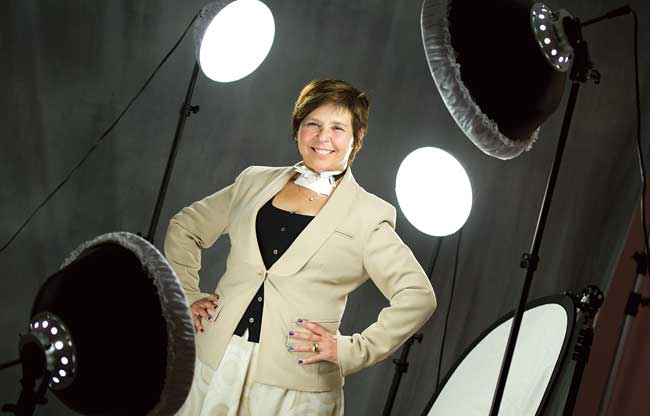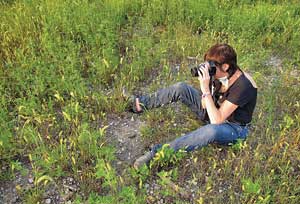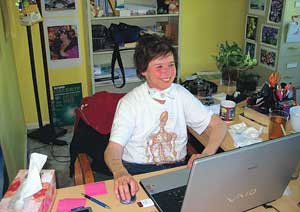Stories of Survival
Debra Sheridan: In Her Own Words
March 21, 2012
 There has always been a camera in my life – from the simple Brownie camera I had as a 7-year-old amateur photographer to the $3 million medical “cameras” that I sold in my professional career.
There has always been a camera in my life – from the simple Brownie camera I had as a 7-year-old amateur photographer to the $3 million medical “cameras” that I sold in my professional career.
With human input, cameras can capture a unique perspective and a pivotal moment in time – whether in a snapshot, or in a CT scan.
Both types of cameras helped save my life – or at least contributed to my “quality of life” – after my diagnosis with stage 4 tonsil cancer.
In the fall of 2006, I was 51 and my life was exactly what I had always dreamed it would be. My husband, Tom Richardson, and I were at a very optimistic point in our lives together and in general. We were in complementary fields; I had a very meaningful position as sales manager for a small mobile CT corporation, and he was providing service for the mobile CT scanners I was promoting. We were living in a comfortable home in Franklin, Tenn., and we were enjoying riding our Harley Davidson motorcycles about 20,000 miles a year.
One evening, I was propped up in bed working on my laptop – I had flown to Boston for a meeting and had been traveling and hadn’t eaten all day. When I arrived at my hotel about 10 p.m., I was starving. I begged the kitchen for something to eat, and they made me a hamburger, something I rarely ate but was grateful for. I literally choked it down and got ready for bed. As I was plunking away on the keyboard, I felt as though I had something stuck in my throat. I put my finger down my throat and felt a lump.
I went into the bathroom and opened my mouth wide and looked in the mirror. Being a typical hotel bathroom, the lighting was poor. I didn’t have a flashlight, so I took my handy dandy pocket digital camera out of my bag, stuck the camera lens in my mouth and snapped a picture.

Debra couldn't wait to get back on two wheels, even while still on chemotherapy.
The tumor was right there in living, vivid color. I knew from my diagnostic imaging experience that ugly = not good. The next morning at the factory I showed the picture to my colleague and told him I was going to set up one of the CT scanners to scan my throat for a more in-depth look at the area. We set up the scanner, I gave directions for the scan parameters, and we commenced scanning. As the scans were reconstructed and displayed on the monitor we could see not only the extent of the tumor but also two lymph nodes that looked like they were involved. I burned the images to disk so I could share them with a radiologist for interpretation. When I asked the radiologist I consulted with what he would advise, he suggested I get a biopsy now, today.
During the weeklong wait for the pathology results I shopped for an oncologist who specialized in neck cancer. My initial consultation with her was the day the final report was released.
She said it wasn’t good.
She advised that the course of chemotherapy and radiation she could prescribe would be difficult to tolerate, that it might even kill me, but would give me the best outcome.
I thought, “Well, I’m young, healthy (except for that pesky tumor in my throat) and determined. Let’s go for the gusto.”
I asked for her support to get me through the treatment and assured her I would supply the will to see it through. We shook hands on the teamwork and set out to eradicate my cancer.
Little did I know what I didn’t know! Even though I’m in the medical profession, asked lots of questions, and did lots of research, I was not fully prepared for the total impact the treatment and its aftermath would have on me.
The treatment eradicated the cancer, thank God. Unfortunately, it left me with an impaired esophagus and trachea – essential for eating and breathing, things most folks take for granted.
We don’t often think about swallowing; we’re born knowing how to do it. But because of the damage, I would have to relearn this basic, automatic function.
I was also unprepared for the absolute fatigue the treatment would cause. As one who had always tapped into the energy of the universe, I’d actually never felt tired my entire life. Suddenly I was so tired I could not stay awake for more than four hours a day. I lost a year of my life to sleep!

Photography helped Debra through her recovery.
The term “quality of life” now took on a whole new meaning.
Going back to work was not even a consideration. I had a feeding tube and no audible voice, neither of which would be conducive to business luncheons and dinners.
Suddenly, I realized without “quality of life,” I had no life at all.
Yes, I had beaten cancer.
But sadly, it had stolen my life (at least temporarily).
With Tom’s support, we went shopping for a team of physicians who would be able to see past the wreck of woman that sat before them and work with us to get me back to life as we knew it. This is when the wonderful folks of Vanderbilt came into my life.
My oncology otolaryngologist (ENT) “guru,” Dr. Wendell Yarbrough*, and his nurse practitioner at the time, Tracey Johnson, got me started on the right track. Physical therapists and speech pathologists scheduled sessions for me, and I went to work in earnest to get my life back. Speech pathologist Laura McBride taught me how to swallow food and liquids without aspirating. Over time and with Laura’s patient coaching, my swallowing improved. At last, I was able to lose the feeding tube.
After a few months of therapy, it became evident that my breathing issues were not resolving and it was decided a tracheostomy would improve both my breathing and my quality of life. Dr. Yarbrough performed the surgery and Laura was at the ready with a Passy-Muir speaking valve.
For the first time in more than a year, I had an audible voice.
About a year and a half after my initial diagnosis I was ready to return to work. My boss was excited to get me back on the sales team, and I had a ticket to fly to Boston the following week to get started.

After a series of setbacks kept her from returning to work in the medical imaging field, Debra turned her photography hobby into a business venture.
During my rehabilitation, I had also been working up to getting back on my bike (did I mention my husband and I liked to ride our Harley Davidson motorcycles?). On the Fourth of July holiday weekend in 2008, he and I were out with some old riding buddies and, as we say in my native Canada, I “failed to negotiate a tricky curve” and hit the guardrail at about 50 miles per hour.
After being airlifted and waking up in the trauma unit at Vanderbilt, my first thought was, “I guess I’m not going to work on Tuesday.”
My spleen, which was bleeding out, was removed, and I had also sustained 18 rib fractures, two broken arms, a torn thumb tendon, and three fractures in my shoulder, as well as significant damage to my lungs and fluid around my heart. Other than this, I was in great shape!
Recovery from the injuries and surgeries put my “get back to work” plan back another year. The surgery to repair my bike accident injuries widened my stoma to the point that off-the-shelf trach tubes no longer prevented air leaks. I lost my functional speaking voice by degrees. Wendy Sumner Alexander, Dr. Yarbrough’s physician assistant, worked with me to find an American manufacturer of trach tubes to design a custom tube that gave me back my speaking voice. I was ready to get back to work – again.
But this time, it wasn’t my body, but the economy, that had other plans for me.
Uncertainty in the medical market was prevalent and my former employer no longer had a place for me. I understood and began working my medical imaging network for another position. I heard the same thing from everyone: the market has frozen, orders previously placed were being cancelled and people are being let go.
It seemed that part of my life – operating, selling and servicing some of the most expensive cameras in the world, cameras that help diagnose diseases like my own – was ending.
But the loss of that career opened a door, one that I’d unlocked years earlier with my Brownie camera. Since I was 7 years old, I had shot thousands of rolls of film – for my friends and family, and for my own enjoyment. In the 1990s, I’d transitioned to digital photography. So, in 2009, Tom and I seized the opportunity to start a photography service company featuring custom photography sessions for families, organizations and product promotions. This opportunity got me back into the business world and interacting with people. We were getting customers and life was looking up.
But then the economy began to shrink even more. Photography was now considered a discretionary expense and our efforts became futile. But during that time, I was able to focus on photography and capture some of those “unique perspectives” and pivotal moments.
One of my favorite photographs – which I shot in 2005, before my diagnosis – is called “Crossroads.” Taken from an overlook in Middle Tennessee, it represents to me the many times in my life, especially in recent years, I’ve been at a crossroads point – a point of choice that’s not so much about “this way” or “that way” but “live” or “don’t live.”

"Crossroads" by Debra Sheridan
Through cancer, a near-fatal motorcycle accident, and career upheaval, I’ve chosen to “live” as best and as fully as I know how.
Despite the physical, emotional and economic hurdles the cancer presented, I often say that my diagnosis with stage 4 tonsil cancer was the best thing to ever happen in my life.
I have had opportunities to help others either find ways to make their recovery manageable or provide their caregivers with helpful techniques to make recovery a little less difficult. And recently, I was (finally) able to go back to work in the field I love, medical imaging sales.
This experience showed me that there are no certain outcomes in life, even if you do all the right things. It taught me that it’s not so much what events occur in your life but rather how you respond to them and seek to uncover the opportunity in them. I learned the power of love – love for and of other people, and love for life, especially. I learned the amazing and abundant power of prayer especially when a number of people from all over the planet pray at the same time for the same help. And I learned that if you focus on a goal, ask others for help when you need it, and celebrate your small victories, there is almost nothing you can’t do.
*Yarbrough is the Barry and Amy Baker Professor of Laryngeal, Head and Neck Research and an Ingram Professor of Cancer Research
Categories: Spring 2012 • Stories of Survival
Tags: cancer survivor • head and neck cancer • survivor • tonsil cancer
Previous Post: Shape the Future
Next Post: News From Around the Cancer Center
2 Comments
Sorry, the comment form is closed at this time.

Deb you are amazing and your story gives new meaning to live each day and celebrate life
Comment by Liz Blight — April 8, 2012 @ 11:40 am
Deb – we are clients of Katies so have followed your successes and setbacks – hearing this story from you is such an inspiration. Wishing you continued good health
Comment by Roberta Goldby — April 9, 2012 @ 12:31 pm